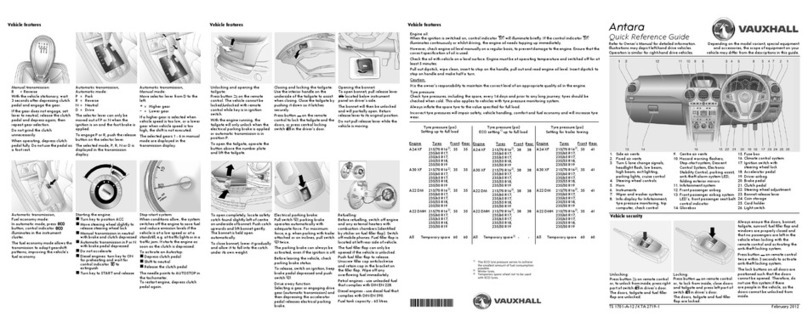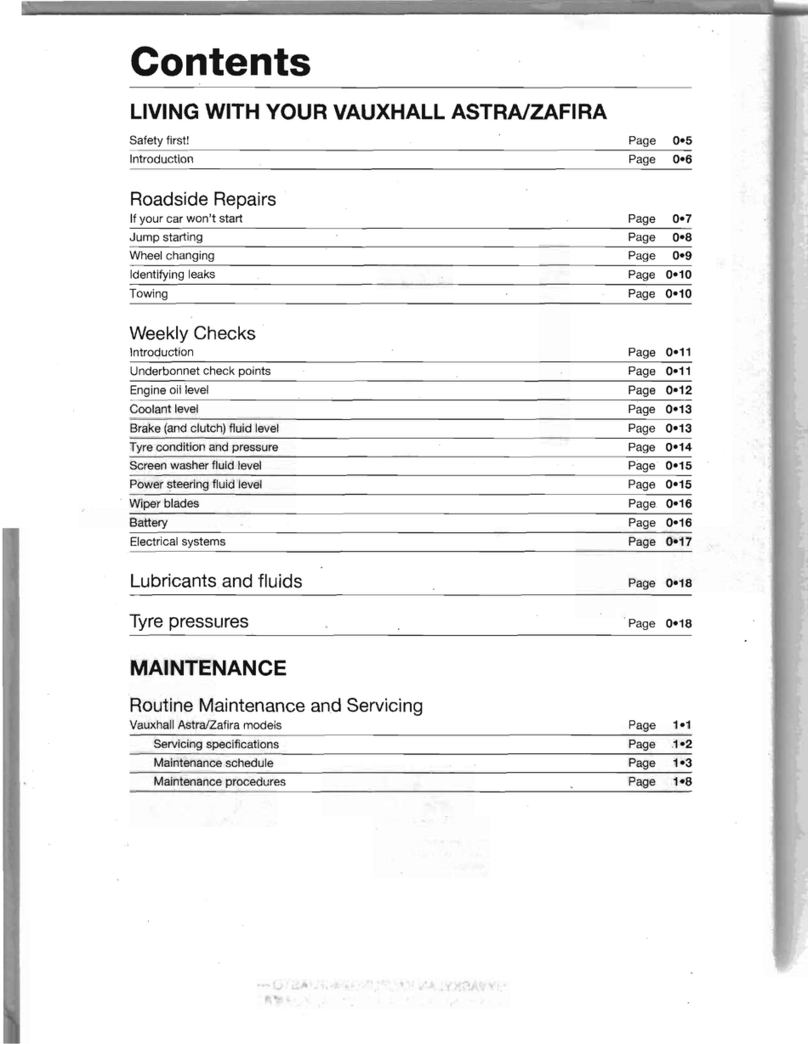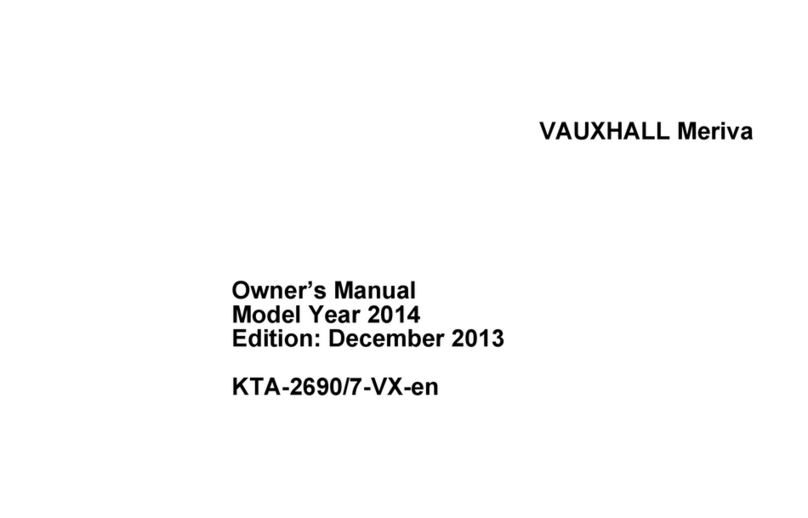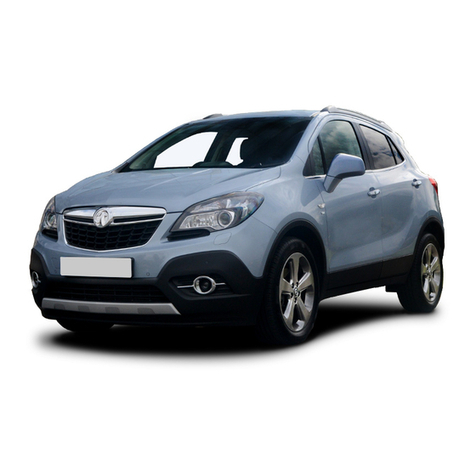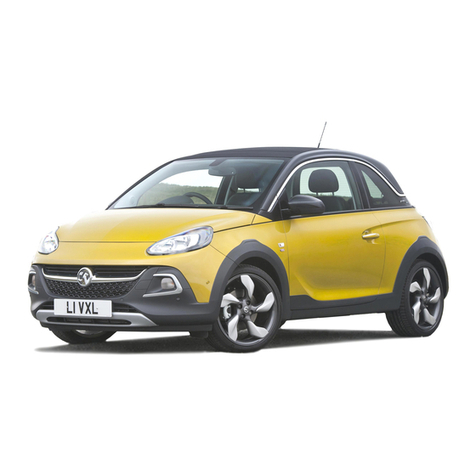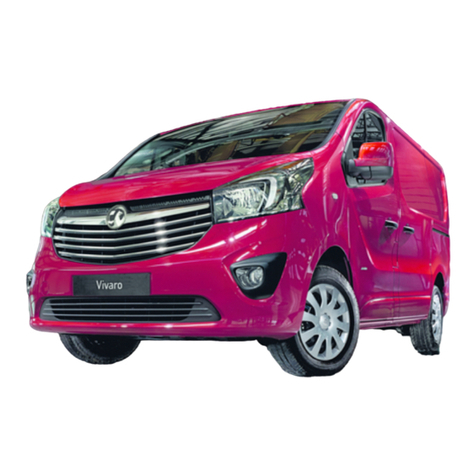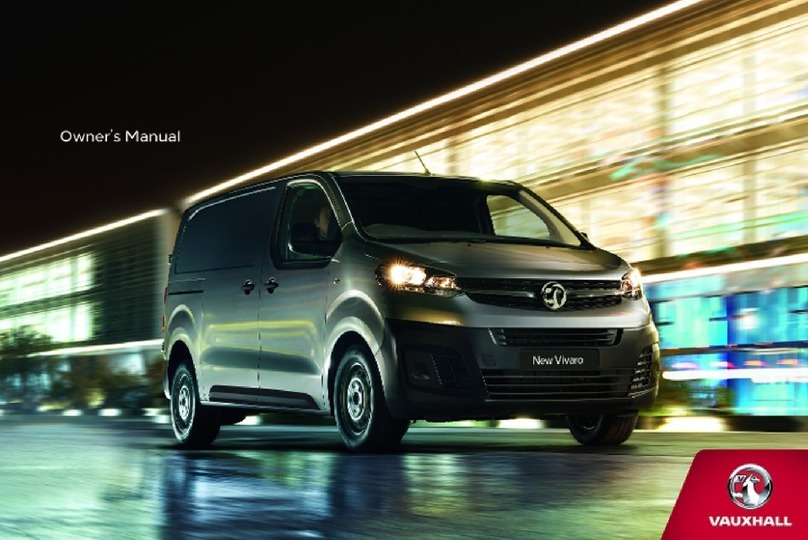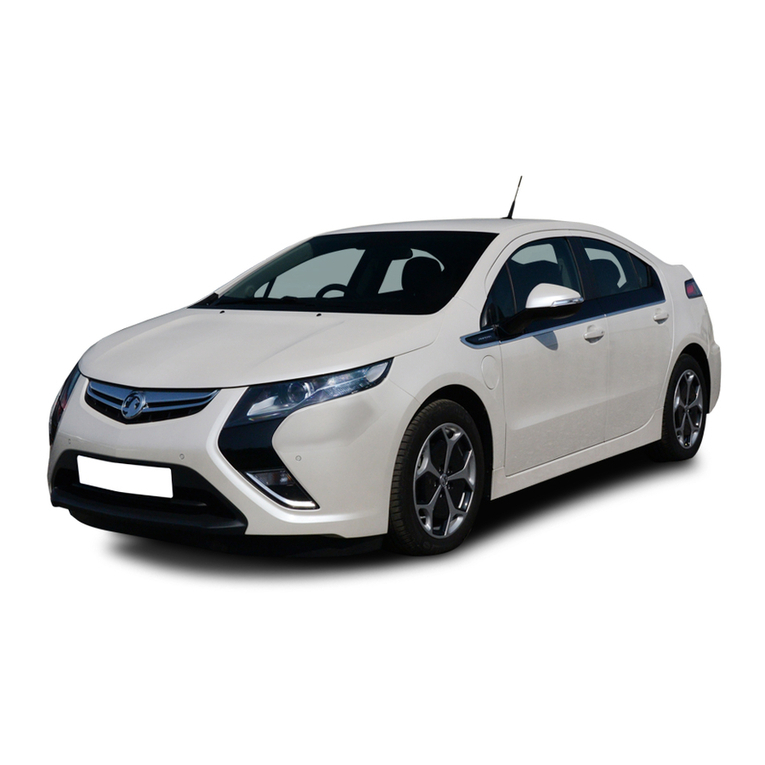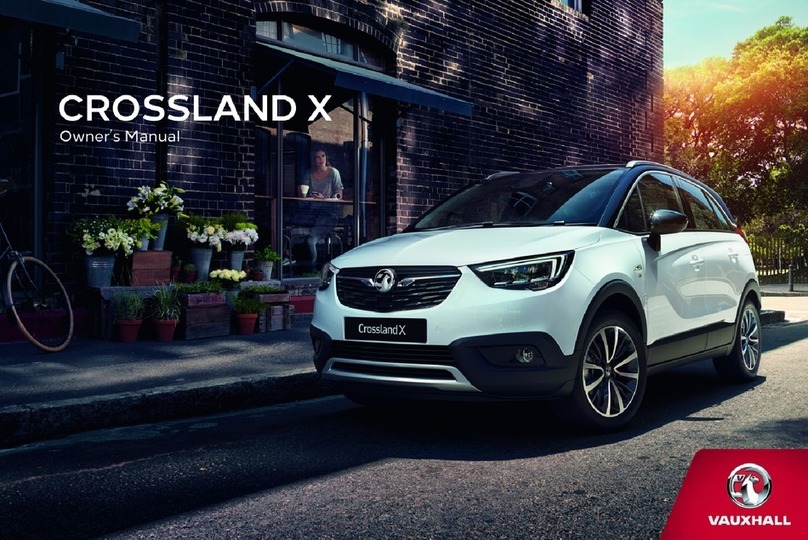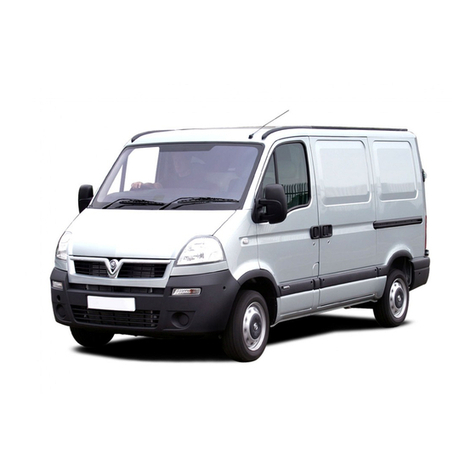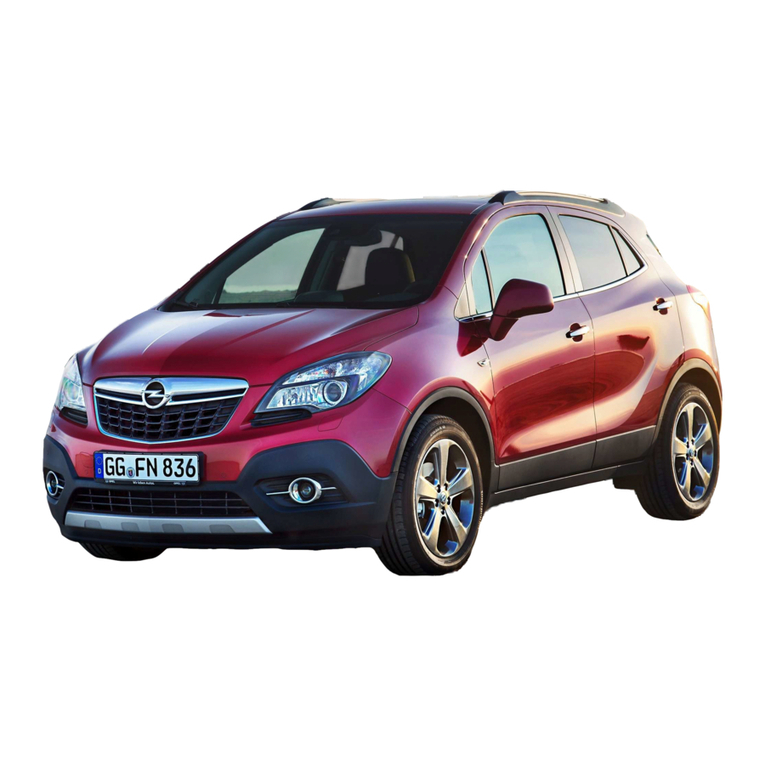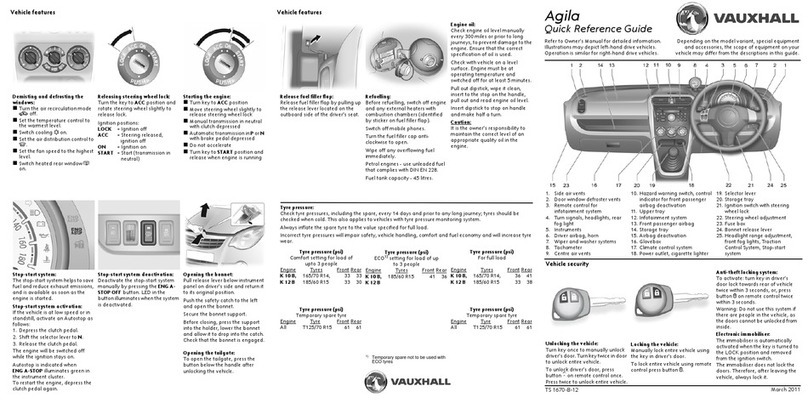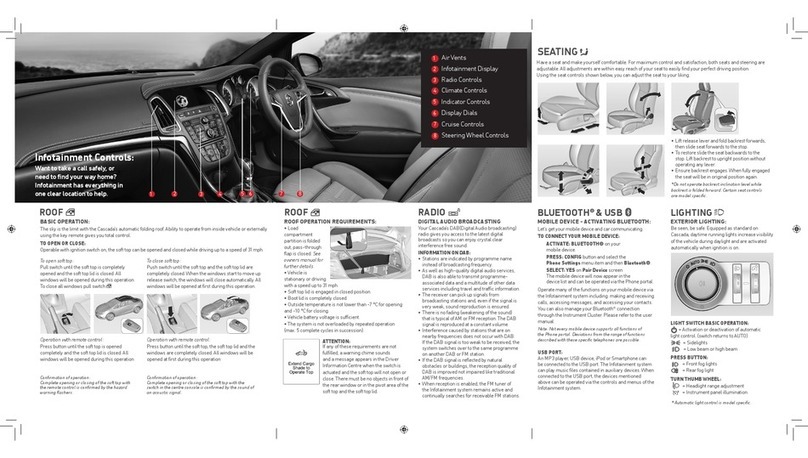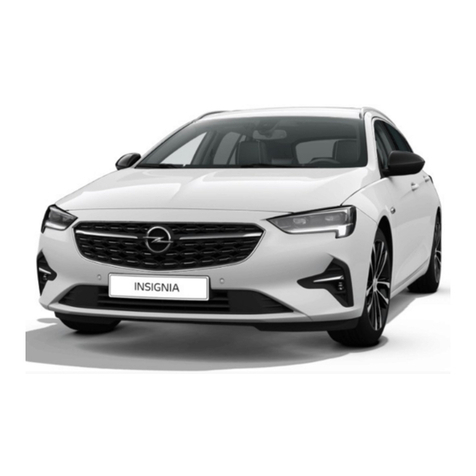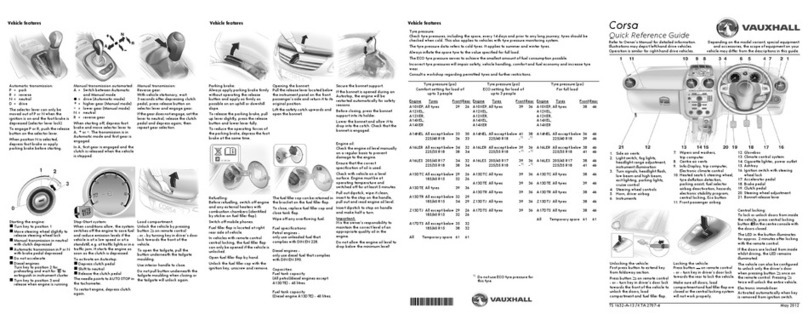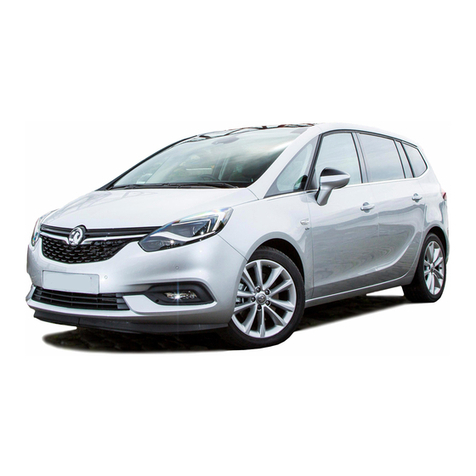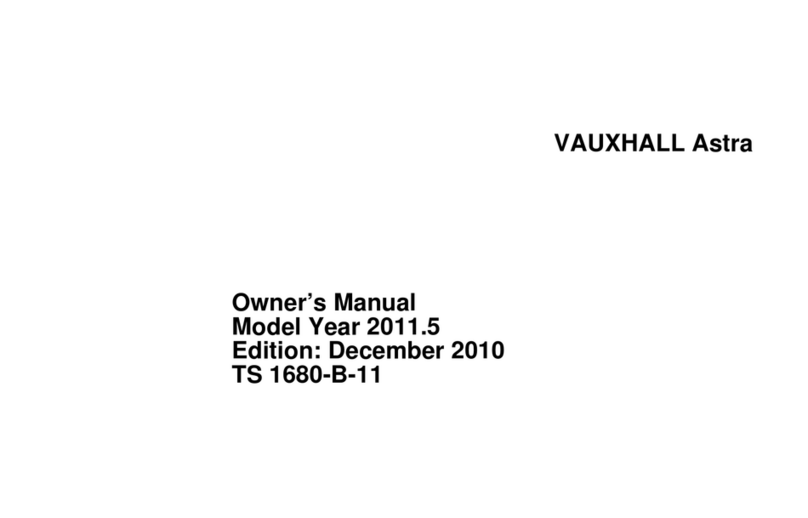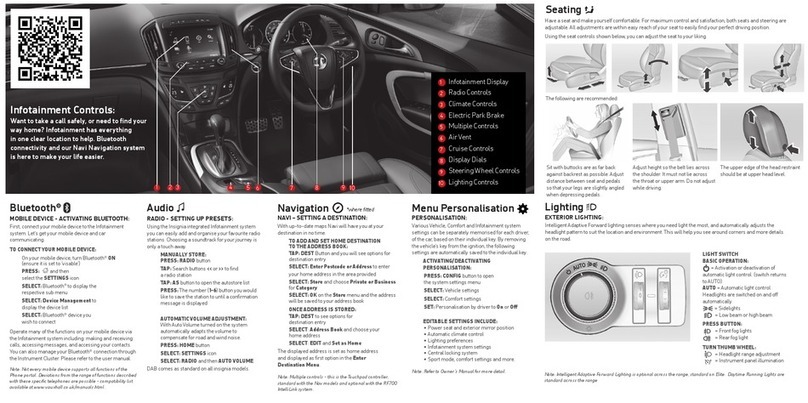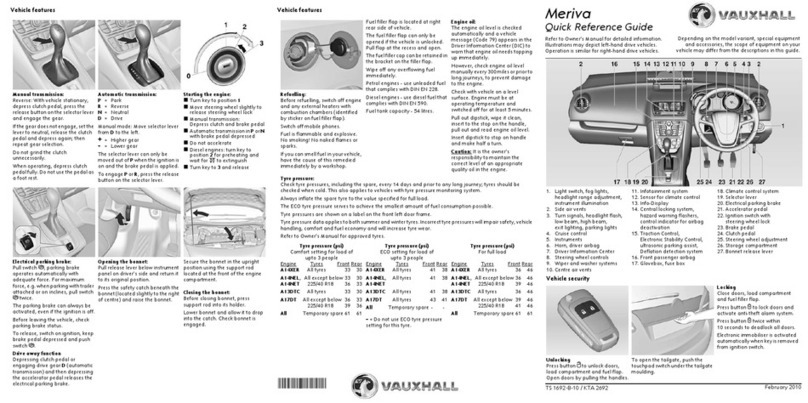Vehicle features Meriva
Quick Reference Guide
Refer to Owner’s Manual for detailed information.
Illustrations may depict left-hand drive vehicles.
Operation is similar for right-hand drive vehicles.
Depending on the model variant, special equipment
and accessories, the scope of equipment on your
vehicle may differ from the descriptions in this guide.
TS 1692-B-13 / KTA 2692-6 January 2013
*KTA-2692-6*
Vehicle features Vehicle features
Unlocking the vehicle:
Press button con remote control
once or twice (depending on
setting) to unlock the doors, load
compartment and fuel filler flap.
Locking the vehicle:
Press button eon remote control.
If the driver’s door is not closed
properly, the central locking system
will not work.
The vehicle can be configured to
unlock only the driver’s door when
pressing button conce on the
remote control. Pressing button c
twice will unlock the entire vehicle.
Central locking button:
To lock or unlock doors from inside
the vehicle, press central locking
button c e in the centre console
with the doors closed. The LED in
the button illuminates when the
doors are locked.
The LED in the button illuminates
for approx. 2 minutes after locking
with the remote control.
Electronic immobiliser:
Activated automatically when key
is removed from ignition switch.
1. Power windows
2. Exterior mirrors
3. Cruise control
4. Side air vents
5. Turn signals, headlight flash,
low beam and high beam,
exit lighting, parking lights,
Driver Information Centre
6. Instruments
7. Steering wheel controls
8. Driver Information Centre
9. Wipers and washers
10. Centre air vents
11. Central locking, hazards,
LED for airbag deactivation
12. Info-Display
13. Sensor for Electronic Climate
Control system
14. Glovebox, fusebox
15. Traction Control, parking assist,
Electronic Stability Control,
tyre deflation detection,
Eco button, fuel selector
16. Climate control system
17. Selector lever
18. Electrical parking brake
19. Ignition switch with
steering wheel lock
20. Horn, driver airbag
21. Bonnet release lever
22. Storage compartment
23. Steering wheel adjustment
24. Light switch, fog lights,
headlight range adjustment,
instrument panel illumination
Automatic transmission:
P= park position
R= reverse gear
N=neutral
D=driveposition
The selector lever can only be
moved out of Pwhen the ignition is
on and the foot brake is depressed.
When the foot brake is not
depressed, the control indicator j
illuminates in the selector lever trim.
To engage Por R, press the release
button on the selector lever.
When position Nis selected,
depress foot brake or apply
parking brake before starting.
Manual mode:
Move selector lever out of
position Dtowards the left to
engage manual mode.
Move lever forwards or backwards
to change gear:
<= Shift to a higher gear
]= Shift to a lower gear
If a higher gear is selected when
vehicle speed is too low, or a lower
gear when vehicle speed is too
high, the shift is not executed.
In manual mode, no automatic
shifting to a higher gear takes
place at high engine revolutions.
Manual transmission:
Reverse gear:
With the vehicle stationary, wait
3 seconds after depressing the
clutch pedal, then press release
button on selector lever and
engage gear.
If the gear does not engage, set the
lever to neutral, release the clutch
pedal and depress again; then
repeat gear selection.
Do not grind the clutch
unnecessarily.
When operating, depress the clutch
pedal completely. Do not use the
pedal as a foot rest.
Starting the engine:
Turn key to position 1
Move steering wheel slightly to
release steering wheel lock
Manual transmission in neutral
with clutch pedal depressed
Automatic transmission in Por N
with foot brake depressed
Do not accelerate
Diesel engines:
Turn key to position 2for
preheating and wait for control
indicator !to extinguish in
instrument cluster
Turn key to position 3 and
release when engine is running
Before restarting or to switch off
engine, turn key back to position 0.
Stop-Start system:
When conditions allow, the system
switches off the engine to save fuel
and reduce emission levels if the
vehicle is at a low speed or at a
standstill, e.g. at traffic lights or in a
traffic jam. It starts the engine as
soon as the clutch pedal is
depressed.
To activate an Autostop:
Depress clutch pedal
Shift selector lever to neutral
Release the clutch pedal
The needle points to AUTO STOP in
the tachometer.
To restart engine, depress clutch
pedal again.
Load compartment:
Unlock the vehicle by pressing
button con remote control once or
twice (depending on setting).
To open the tailgate, push the
touchpad switch underneath the
tailgate moulding.
Use one of the interior handles on
the underside of the tailgate to
close.
Do not push the touchpad switch
underneath the tailgate moulding
when closing or the tailgate will
unlock again.
Secure the bonnet support.
If the bonnet is opened during an
Autostop, the engine will be
restarted automatically for safety
reasons.
Closing the bonnet:
Before closing, press the bonnet
support into its holder.
Lower the bonnet and allow it to
drop into the catch. Check that the
bonnet is engaged.
Electrical parking brake:
Pull switch J:electrical parking
brake is applied automatically.
For maximum force, e.g. parking
on inclines, pull switch J twice.
To release, switch on ignition. Keep
foot brake depressed then push
switch J.
Drive away function:
Depressing clutch pedal or
engaging D(automatic
transmission) and then depressing
the accelerator pedal releases the
electrical parking brake
automatically.
Opening the bonnet:
Pull the release lever located below
the instrument panel on the driver’s
side and return it to its original
position.
Press the safety catch below the
bonnet and open the bonnet.
Refuelling:
Before refuelling, switch off engine
and any external heaters with
combustion chambers (identified
by sticker on fuel filler flap).
Switch off mobile phones.
Fuel filler flap is located at right
rear side of vehicle.
The fuel filler flap can only be
opened if the vehicle is unlocked.
Pull fuel filler flap at the recess and
open.
Unscrew the fuel filler cap
anticlockwise and remove.
The fuel filler cap can be retained in
the bracket on the fuel filler flap.
For refuelling, fully insert the pump
nozzle and switch it on.
To close, replace fuel filler cap and
close fuel filler flap. After automatic
cut-off, it can be topped up with
maximum two doses of fuel.
Wipe off any overflowing fuel.
Fuel specifications:
Petrol engines - Only use unleaded
fuel that complies with DIN EN 228
or E DIN 51626-1.
Diesel engines - Only use diesel fuel
that complies with DIN EN 590.
Capacities:
Fuel tank capacity
(All petrol/diesel engines) - 54 litres.
Engine oil:
Check the engine oil level manually
on a regular basis to prevent
damage to the engine.
Ensure that the correct
specification of oil is used.
Check with vehicle on a level
surface. Engine must be at
operating temperature and
switched off for at least 5 minutes.
Pull out dipstick, wipe it clean,
insert to the stop on the handle,
pull out and read engine oil level.
Insert dipstick to stop on handle
and make half a turn.
Important:
It is the owner’s responsibility to
maintain the correct level of an
appropriate quality oil in the
engine.
Do not allow the engine oil level to
drop below the minimum level!
Tyre pressure:
Check tyre pressures, including the spare, every 14 days and prior to any long journey; tyres should be checked
when cold. This also applies to vehicles with tyre deflation detection system.
The tyre pressure data refers to cold tyres. It applies to summer and winter tyres.
Always inflate the spare tyre to the value specified for full load.
The ECO tyre pressure serves to achieve the smallest amount of fuel consumption possible.
Incorrect tyre pressures impairs safety, vehicle handling, comfort and fuel economy and increases tyre wear.
Tyre pressure (psi)
Comfort setting for load of
upto 3 people
Engine Tyres Front Rear
A14XER 195/65 R15 33 30
205/55 R16 33 30
225/45 R17 33 30
225/40 R181) 33 30
A14NEL 195/65 R15 33 30
205/55 R16 33 30
225/45 R17 33 30
225/40 R181) 36 33
B14NEL 195/65 R15 33 30
205/55 R16 33 30
225/45 R17 33 30
225/40 R181) 33 30
A14NET, 205/55 R16 33 30
B14NET 225/45 R17 33 30
225/40 R181) 36 33
A13DTC 195/65 R15 33 30
205/55 R16 33 30
225/45 R17 33 30
225/40 R181) 33 30
A13DTE 195/65 R15 33 30
205/55 R16 33 30
225/45 R17 33 30
225/40 R181) 33 30
A17DT, 195/65 R152) 3) 36 33
A17DTC, 205/55 R16 36 33
A17DTS, 225/45 R17 36 33
A17DTI 225/40 R181) 39 36
All Temporary spare 61 61
1) With reduced steering angle.
2) Only permitted in combination
with weight reduction package.
3) Only permitted with A17DT,
A17DTC and A17DTI.
Tyre pressure (psi)
For full load
Engine Tyres Front Rear
A14XER 195/65 R15 36 46
205/55 R16 36 46
225/45 R17 36 46
225/40 R181) 36 46
A14NEL 195/65 R15 36 46
205/55 R16 36 46
225/45 R17 36 46
225/40 R181) 39 46
B14NEL 195/65 R15 36 46
205/55 R16 36 46
225/45 R17 36 46
225/40 R181) 36 46
A14NET, 205/55 R16 36 46
B14NET 225/45 R17 36 46
225/40 R181) 39 46
A13DTC 195/65 R15 36 46
205/55 R16 36 46
225/45 R17 36 46
225/40 R181) 36 46
A13DTE 195/65 R15 36 46
205/55 R16 36 46
225/45 R17 36 46
225/40 R181) 36 46
A17DT, 195/65 R152) 3) 39 46
A17DTC, 205/55 R16 39 46
A17DTS, 225/45 R17 39 46
A17DTI 225/40 R181) 41 46
All Temporary spare 61 61
1) With reduced steering angle.
2) Only permitted in combination
with weight reduction package.
3) Only permitted with A17DT,
A17DTC and A17DTI.
Tyre pressure (psi)
ECO setting for load of
upto 3 people
Engine Tyres Front Rear
A14XER 195/65 R15 41 38
205/55 R16 41 38
225/45 R17 41 38
225/40 R18 -1) -1)
A14NEL 195/65 R15 41 38
205/55 R16 41 38
225/45 R17 41 38
225/40 R18 -1) -1)
B14NEL 195/65 R15 41 38
205/55 R16 41 38
225/45 R17 41 38
225/40 R18 -1) -1)
A14NET, 205/55 R16 41 38
B14NET 225/45 R17 41 38
225/40 R18 -1) -1)
A13DTC 195/65 R15 41 38
205/55 R16 41 38
225/45 R17 41 38
225/40 R18 -1) -1)
A13DTE 195/65 R15 41 38
205/55 R16 41 38
225/45 R17 41 38
225/40 R18 -1) -1)
A17DT, 195/65 R152) 3) 43 41
A17DTC, 205/55 R16 43 41
A17DTS, 225/45 R17 43 41
A17DTI 225/40 R18 -1) -1)
All Temporary spare -1) -1)
1) Do not use ECO tyre pressure
setting for this tyre.
2) Only permitted in combination
with weight reduction package.
3) Only permitted with A17DT,
A17DTC and A17DTI.
